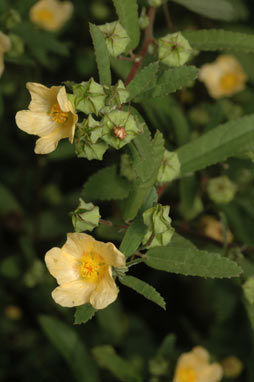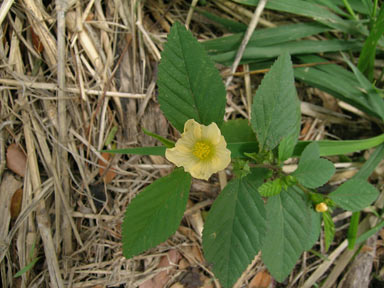Sida rhombivolia aka Wireweed, Broom Jute
By Diann Dirks 9-27-18
Flowers and developing seed capsules
Photograph by: Fagg, M.
Image credit to Australian National Botanic Gardens
Here is one of those amazing plants that just blow the mind with their vast usefulness.
Flowering stem
Photograph by: Shepherd, R.C.H.
Image credit to Australian National Botanic Gardens
Sida rhombifolia is a perennial woody small bush that grows especially well in the Southeast. But the family of Sida can be found worldwide and has been used in traditional medicines for thousands of years in Ayervedic (India), Traditional Chinese Medicine, Eclectic (19th century medical practice in America), and numerous native medicine practices. Currently it is being researched in labs for pharmacruticals. It was introduced in the 19th c in this country by Eclectic doctors and has gone native.
I found this plant in my garden and had ID’ed it after I had been pulling it as a weed for many years. When I realized the treasure I had I now cultivate it and use it for many things. It even can be used to make fiber for canvas, fish nets, cordage, etc. The stems make lovely brooms and has been used for this for centuries in various cultures.
But the real treasure is in the use for medicine. All parts of the plant are medicinal – leaves, flowers, seeds, stems, and roots. Usually people use the leaves for medicine for ease of harvesting. But the other parts can also be harvested and used.
You can make a tea, dry and powder it and use it as a powder or put it in capsules, make water extracts, make alcohol tincture, put it in oil and use it as a poultice, or make a tea for eye drops depending on what use you want to make of it.
Broadly speaking it is an incredibly powerful antibiotic, antiviral and anti-microbial effective against such usually hard to treat illnesses as TB, E.coli, Salmonella, various kinds of pneumonia, Malaria, cancer of the red blood cells, Whopping cough, UTIs, Bronchitis and other respiratory illnesses, colic, infected and septic wounds, eye infections, Hepatitus B, dysentery, and Staph infections (including resistive kinds). It kills candida albicans, and a host of fungal and protozoan infections, even parasites such as malaria to name just a few.
An adaptogenic is a medicinal property that means that it evens things out – when there’s too much of something, it lowers it to normal, likewise too little of something. This is important because much disease is because things go out of control or need boosting. Adaptogenics do that. Sida R. is an adaptogenic of importance.
It protects many functions of the body – the stomach lining (against ulcers), the intestines, the eyes, the liver, the kidneys (even helps with kidney stones), stops breast cancer from growing, increases antioxidants in heart tissue for heart health and repair, keeps blood sugar in range (for diabetes), is an antioxidant that knocks out free radicals – those factors that cause mutation in the cells and wreck many functions inside the organs and systems of the body, and kills parasites that do many kinds of damage all over the body. It even handles herpes siplex – those pesky canker sores in the mouth. It protects against respiratory problems like colds and flu, but also asthma and TB. It helps against diarrhea and fevers. It works to heal the skin of rashes, eczema, even impetigo.
It is effective against long term debilitating infections such as Lyme, Malaria, and Dysentery which kill a lot of people all over the world.
It is also a very nutritional plant with protein levels up to 25% – used in many cultures as their primary protein source depending on how it’s grown.
It is used to treat pit viper snake bites powerfully. It neutralizes the hemotoxins that destroy blood cells (and kills people).
It is a pain killer useful in treating rheumatism and joint pain and swelling, fractures, and sinusitis as well as cramps.
It’s also used to treat farm animals except goats (bad for goats).
This just hits the high points. When doing the research I kept coming across things that really amazed me such as the fact that it protects and rebuilds red and white blood cells which means it builds the immune system, and is the only plant that specifically protects the red blood cells which is why it’s good for anemia and myeloma (cancer of the red blood cells).
Generally it’s also healthy as it lowers blood triglycerides and cholesterol. And it is used as an antidepressant and anti-seizure.
It is used later in pregnancy in traditional medicines, but shouldn’t be used if wanting to become pregnant or early in a pregnancy.
It grows very well in the southeast and self-seeds. Once I stopped pulling it as a weed it had become abundant in my garden allowing for a lot of harvesting.
How to use it is covered very well in the first site below including how to make your own medicinal preparations. If you want to be self-reliant and have a powerful ally in keeping healthy, or even in survival situations, Sida R. is a wonderful friend. And you can eat it or make rope, clothing, brooms, and other fiber with it. She is a treasure. Enjoy.
Check out these resources:
http://tipsdiscover.com/health/systemic-herbal-antibiotics-sida/
http://www.eattheweeds.com/sida-wireweed/
https://www.ncbi.nlm.nih.gov/pubmed/21970621
http://www.holistic-online.com/Herbal-Med/_Herbs/h_sida-rhombifolia.htm
https://en.wikipedia.org/wiki/Sida_rhombifolia for description and pictures


